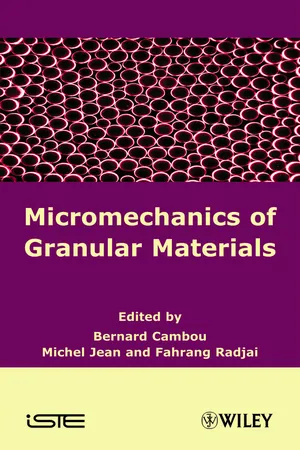
Micromechanics of Granular Materials
- English
- ePUB (mobile friendly)
- Available on iOS & Android
Micromechanics of Granular Materials
About this book
Nearly all solids are compised of grains. However most studies treat materials as a continious solid. The book applies analysis used on loose granular materials to dense grainular materials. This title's main focus is devoted to static or dynamic loadings applied to dense materials, although rapid flows and widely dispersed media are also mentioned briefly. Three essential areas are covered: Local variable analysis: Contact forces, displacements and rotations, orientation of contacting particles and fabric tensors are all examples of local variables. Their statistical distributions, such as spatial distribution and possible localization, are analyzed, taking into account experimental results or numerical simulations. Change of scales procedures: Also known as "homogenization techniques", these procedures make it possible to construct continuum laws to be used in a continuum mechanics approach or performing smaller scale analyses. Numerical modeling: Several methods designed to calculate approximate solutions of dynamical equations together with unilateral contact and frictional laws are presented, including molecular dynamics, the distinct element method and non-smooth contact dynamics. Numerical examples are given and the quality of numerical approximations is discussed.
Frequently asked questions
- Essential is ideal for learners and professionals who enjoy exploring a wide range of subjects. Access the Essential Library with 800,000+ trusted titles and best-sellers across business, personal growth, and the humanities. Includes unlimited reading time and Standard Read Aloud voice.
- Complete: Perfect for advanced learners and researchers needing full, unrestricted access. Unlock 1.4M+ books across hundreds of subjects, including academic and specialized titles. The Complete Plan also includes advanced features like Premium Read Aloud and Research Assistant.
Please note we cannot support devices running on iOS 13 and Android 7 or earlier. Learn more about using the app.
Information
Chapter 1
Experimental and Numerical Analysis of Local Variables in Granular Materials 1
1.1. Introduction














1.2. Description of granular texture
Table of contents
- Cover
- Title Page
- Copyright
- Introduction
- Chapter 1: Experimental and Numerical Analysis of Local Variables in Granular Materials
- Chapter 2: The Stress Tensor in Granular Media and in other Mechanical Collections
- Chapter 3: Multiscale Techniques for Granular Materials
- Chapter 4: Numerical Simulation of Granular Materials
- Chapter 5: Frictionless Unilateral Multibody Dynamics
- List of Authors
- Index